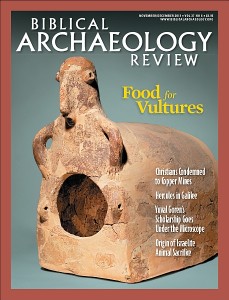Biblical Archaeology Review, November/December 2011
Features
Condemned to the Mines
Copper production & Christian persecution
Damnatio ad metalla—condemned to the mines! Tantamount to a death sentence. For the past 20 years, we have been exploring these mines about 30 miles southeast of the Dead Sea in the Faynan district of Jordan.a In ancient times, these copper mines represented hell on earth to...Read more ›
Excarnation: Food For Vultures
Unlocking the mysteries of Chalcolithic ossuaries
For nearly a century before the Romans destroyed the Temple in 70 C.E., Jews, especially in the Jerusalem area, would inter the bones of their deceased in stone boxes, or ossuaries, about 2 feet long and a foot high. The ossuary had to be long enough to...Read more ›
Hercules in Galilee
Sometimes nature is a better archaeological excavator than humans. So it was a year ago at our excavation of Hippos/Sussita overlooking the Sea of Galilee.a Our 2010 summer excavation season was followed by the torrential rains of an Israeli winter. Surveying a bathhouse from about 150 B.C.E...Read more ›
Fudging with Forgeries
A closer look at Professor Yuval Goren’s “scholarship”
I must confess at the outset that I should be disqualified from writing this piece because its subject, Professor Yuval Goren of Tel Aviv University, has charged me with playing a “pivotal role” in the forgeries alleged in the so-called forgery trial of the century, now awaiting...Read more ›
The Origin of Israelite Sacrifice
Sacrificing animals to God—a major activity in the Temple—must certainly seem odd to us in the 21st century. Where did the practice come from? The Israelites didn’t invent it. Scholars have hypothesized its origin in prehistoric times, not long after the domestication of plants and animals. Others...Read more ›

